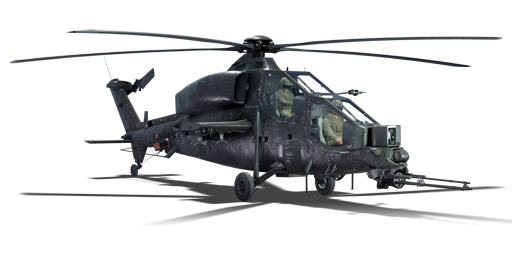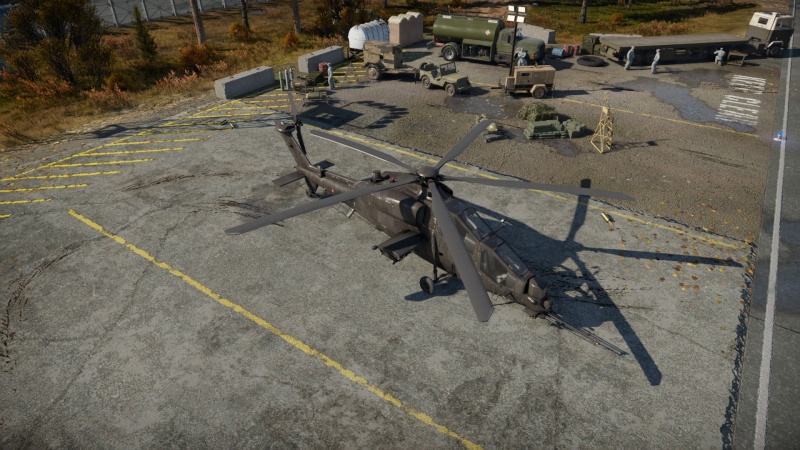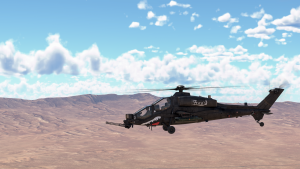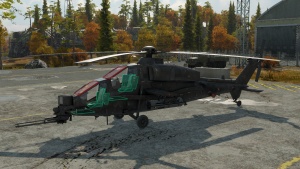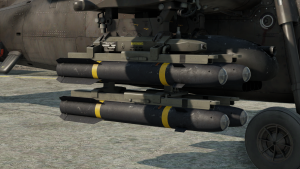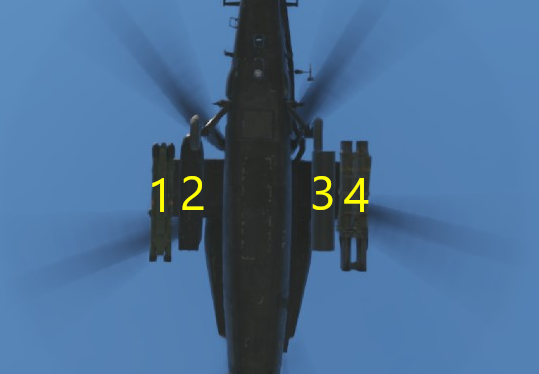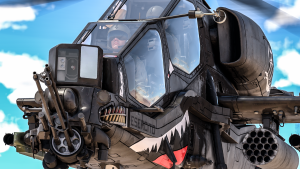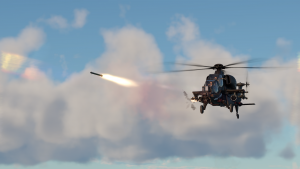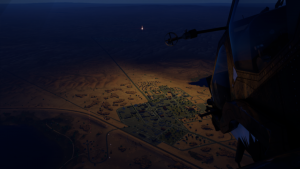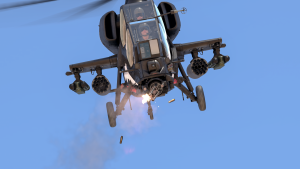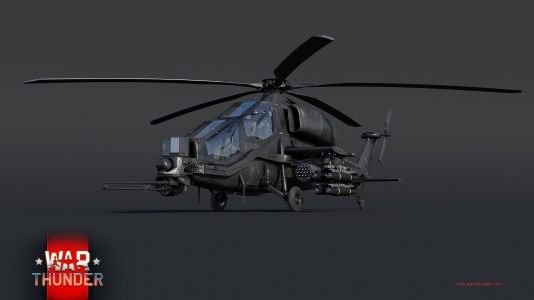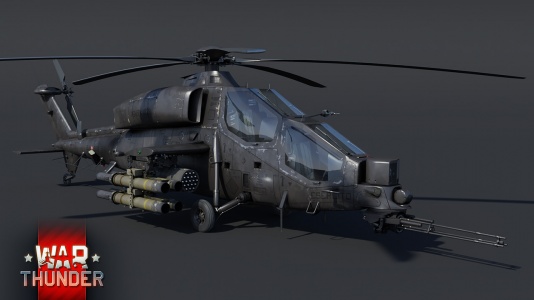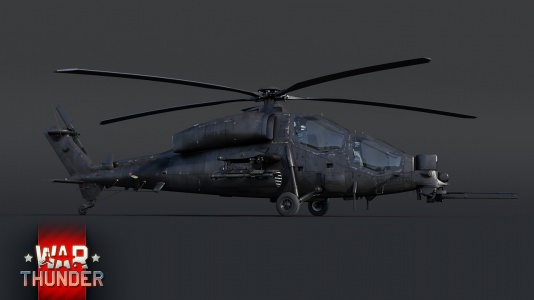A129CBT
| This page is about the Italian attack helicopter A129CBT. For other versions, see AW129 (Family). |
Contents
Description
After the creation of the A129 International, and its failure to be exported to other countries, Italy, Spain, Great Britain, and the Netherlands signed a memorandum in 1986 to have a better version of the A129 developed. The project, named the Joint European Helicopter, called for more powerful engines, a new rotor system, retractable landing gear, improved armament, and improved sensors. However, the project was cancelled in 1990, with Great Britain and the Netherlands buying the AH-64 Apache and Spain opting for the Eurocopter Tiger. Nevertheless, thanks to the project the Italians were able to improve the A129 and put it into service as the A129 Mangusta 'Combat' (A129CBT), which had modernised avionics. It would eventually be used in various theatres of war such as Iraq and Afghanistan.
Introduced in Update "Hot Tracks", the A129CBT is an excellent helicopter for its low-speed manoeuvrability and acceleration that allows it to hit enemy targets and exit quickly. The A129CBT is equipped with several armaments, the best of which are the AGM-114B Hellfires that can hit enemies hard, while for defence against other enemy helicopters and aircraft, the A129CBT equips the Mistral, which can chase down targets much better than the ATAS. You can also count on a 20 mm rotary 3-barrel cannon that can shoot down most light targets.
General info
Flight performance
Outfitting the A129CBT with general payload options (Hellfires, rockets, air-to-air missiles) does not make the helicopter any slower than its adversaries, in fact at times you'll easily be one of the fastest helicopters on the battlefield. The A129CBT is able to do manoeuvres other helicopters can only dream about, even with full payload options. In Ground RB matches however, there should not be many times you'll have to move too much to avoid enemies. You are able to get good positions thanks to your speed, and, if done right, you will be able to dodge incoming missiles from enemy SPAA or jet aircraft.
| Characteristics | Max Speed (km/h at 1,000 m) |
Max altitude (metres) | |
|---|---|---|---|
| AB | RB | ||
| Stock | 269 | 253 | 5400 |
| Upgraded | 319 | 295 | |
Survivability and armour
The A129CBT is not very survivable. Like many helicopters at its battle rating, it is prone to exploding into many pieces after a hit from a missile. It does have some armour on the cockpit area, but in battles that won't really protect you from anything you'll face. The A129CBT uses Kevlar boron carbide, a composite material which is limited only to instrument, floor and side panels around the cockpit. It does not provide the same level of protection as seen on other helicopters.
Modifications and economy
Armaments
| Ballistic Computer | ||
|---|---|---|
| CCIP (Guns) | CCIP (Rockets) | CCIP (Bombs) |
| |
|
|
Offensive armament
The A129CBT is armed with:
- A choice between two presets:
- 1 x 20 mm TM197B cannon, nose-mounted ball turret (750 rpg) + 90 x countermeasures
- 1 x 20 mm TM197B cannon + 90 x countermeasures + IRCM
Suspended armament
The A129CBT can be outfitted with the following ordnance:
| 1 | 2 | 3 | 4 | ||
|---|---|---|---|---|---|
| 12.7 mm FN M3P machine guns (250 rpg) | 1* | 1* | |||
| FFAR Mighty Mouse rockets | 3* | 3* | |||
| Hydra-70 M247 rockets | 7, 19 | 7, 19 | 7, 19 | 7, 19 | |
| AGM-114B Hellfire missiles | 2, 4 | 2, 4 | |||
| ATAS (AIM-92) missiles | 2 | 2 | 2 | 2 | |
| BGM-71C Improved TOW missiles | 2, 4 | 2, 4 | |||
| BGM-71D TOW-2 missiles | 2, 4 | 2, 4 | |||
| Mistral missiles | 2 | 2 | 2 | 2 | |
| * FFAR rockets can only be carried concurrently with the FN M3P gunpods on the same hardpoint | |||||
| Default weapon presets | |
|---|---|
| |
Usage in battles
Ground RB
The A129CBT is a great helicopter for its battle rating and is effective both in downtiers and uptiers. For Ground RB, it is recommended you bring in a light vehicle able to scout, with access to the "Air strike" modification. This will mean that once you have captured a point, and scouted a vehicle, you'll be able to get into the helicopter with Hellfires straight away if you happen to get knocked out early. This is the best strategy as if you manage to pull it off inside a match that has only just started, you will likely surprise unsuspecting enemies who might think it's still to early to worry about enemy aircraft.
For Ground RB, you have two options:
With enough spawn points, you can bring Hellfire missiles, the best overall loadout for the A129CBT. With the Hellfires, you'll easily be able to pick off players from a distance. If spawning in during the early minutes of a match, the Hellfires will be a dangerous weapon for pretty much any enemy vehicle you'll be able to track. If you run out of Hellfires during your match, it is advised you return to base to rearm. If not, and you haven't had the chance to use your rocket pods yet, utilize them whilst still being useful to your team. With rockets, you'll need to stay low to avoid any incoming SPAA or, if there are no SPAA, fly above the battlefield and take out priority targets. Usually, sticking behind mountains or tree lines will suffice. This should not pose a challenge as the A129CBT has access to the ballistic computer. You'll need to quickly scan, engage, and then disengage. If you feel as if you are still able to fight, you still have access to your main 20 mm cannon, which is effective against soft targets and Western MBTs.
For a first spawn, you can bring the AIM-92 Stingers or Mistral air-to-air missiles and Hydra-70 M247 rockets, or a full load of Hydra-70s. Do keep in mind that the A129CBT flies a bit sluggish with the full rocket load compared to the AAMs and half rocket load for obvious reasons. You won't be as manoeuvrable whilst bringing a full rocket load, so you must be sure that you can score multiple frags with them and the ballistic computer. This is where bringing air-to-air missiles comes into play. AAMs are great for destroying enemy first-spawn helicopters and enemies on CAS duty if you survive until the middle of the match. The Mistrals were once inadequate against helicopters, specifically Russian ones, that were the most common in matches before their respective BR increases. Since the Mi-28NM and the Ka-52 now reside at 11.0, it's physically impossible to face them unless you put a 10.0 vehicle in your lineup. These helicopters were the reason Mistrals weren't effective; they were the most common and deadly helicopters, and they were quite modern as well, as these helicopters had MAW systems on board. This meant that, upon firing a Mistral at them, dozens of flares and chaff would spit out of the side of their helicopters, leading your missile off-course, whereas with a Stinger, they wouldn't do that, as they're more resistant to countermeasures than the Mistral. However, the Stingers pull less than the Mistral, and against aircraft, you'd have to shoot a Stinger when an aircraft was in a straight line. With the Mistral however, you can just fire them and the nimble 12G missile is on its way to score you yet another air frag. And since the Mi-28NM and the Ka-52 are 11.3, the main drawback of the Mistrals were eliminated. The only enemy you can still face with MAW systems on board is the Ka-50, but since most of their pilots sit back in a comfortable spot far away with Vikhrs, you won't attain a missile lock on them at range anyways.
38 rockets are more than enough if you are precise with the ballistic computer. You have 19 clicks - 19 shots to destroy the enemy with 38 rockets. With enough precision, especially accounting for the ballistic computer, that could be 19 frags. With 38 rockets, you'll be more manoeuvrable compared to a full rocket load, as well as have an early anti-air capability for your team if there are no first-spawn SPAAs on your team. This is a great way to deter all helicopters, and later, CAS jets like the A-4B, A-4E Early, G.91 R/4 (Germany), and others.
The tactical part
All of this unearths a new playstyle for the A129CBT: playing tactically. You can bide your time and shoot down enemy CAS jets and helicopters that may spawn both early and later in the match, or you can fly around terrain, even capturing zones, supporting a team to a strategic point, and destroying ground targets with the sizable amount of Hydras on board the helicopter. The A129CBT is very functional when supporting allied ground units right on top of them.
One strategy is to actually take a capture point yourself. For example, in Domination matches with three capture points, the amount of enemies at each capture point is rarely balanced evenly. This leaves you to attack the capture point with the least amount of enemies and potentially capture the point yourself if the enemies are eradicated from said point and there are no nearby enemies to fire at you. Long range maps like Maginot Line and Fields of Poland are great for this. It is best to do this on long range maps, but this is doable in close range/urban matches if the player amount is small during that match or the capture point has a lot of cover for you to hide behind while capturing.
Make sure not to put yourself into the fray and crosshairs of half the enemy team while close to the ground. To avoid this, fly up a bit as soon as you spawn. If you are prompted with a laser warning and you know it's an SPAA, dive while firing countermeasures and lower your collective to prevent a crash at low altitude. Usually, a laser warning means an MBT is pointing a laser at you, which isn't much of a threat. If not, you can utilize the thermal sight to determine where most of the enemy team is going and where they will be, if there are any SPAAs that haven't spotted you yet, and who will be the knot in your team's battle on the ground (for instance, an MBT in a sniper spot or a M3A3 Bradley in a hull down position.)
While you're up there, try to plot a route where you can engage while taking as minimal fire as possible, while also setting yourself a priority target like an SPAA, an MBT in a good position, or a group of light tanks/MBTs going to one area. Then, fly back down to the safety of the terrain and initiate your attack or stay high up if you haven't been spotted by enemy tanks. There are both advantages and disadvantages for flying high and low, and choosing which way to fly is usually map dependent.
When flying high, you are able to see the battlefield and identify priority targets for both you and your team. You can initiate SPAA duels if enemy SPAAs happen to spawn first or mark nearby enemies for teammates and squadmates. Diving back down low gets you to the helicopter's cruising speed of around 230-250 km/h, where you can initiate your attack run and you are able to destroy tanks of all types with the turret alone (top-down) once directly above the battlefield. Staying up at altitude with a turret is not a bad strategy at all. It's a great way to spot enemies for your teammates as well as get assists if you'd like to spawn in an aircraft afterwards.
The downsides are that you run the risk of being spotted by the entire enemy team. There is also no radar clutter for the enemy SPAAs and diving back down can result in crashing.
On the other hand, flying low gives you the element of surprise and keeps you safe from potential SPAAs. You're also able to retreat faster as the helicopter is usually at maximum speed. However, crashing is more likely and entering the battlefield will have you subjected to a hail of bullets. If you bleed all of your speed in a turn, you will be a sitting duck and finding good targets is way harder while flying at 230 km/h just a few feet off the ground through a warzone.
With enough practice (and rockets), you can even clear out groups of light tanks rushing the capture points early in the game at range. Sniping can be applied to soft targets as well. However, it is advised that you avoid sniping MBTs unless absolutely necessary as it is seen as a waste of rockets as they can take more hits than light targets. It is best to only fire rockets at immediate threats like SPAAs.
Sometimes the enemy SPAA isn't an SPAA at all. Enemy IFVs and tanks like the Leopard 2K and the AMX-40 will proudly take the role of an SPAA if one didn't spawn early on their team. This is what you need to watch out for. While flying above the battlefield, 20 mm autocannon fire and well-placed shots with ATGMs is nothing to sneeze at. Make sure to always stay vigilant against these types of tanks. The turret is more than enough to deal with the light targets like the M3A3 Bradley or the Type 89, but the bigger targets like the Leopard 2K may need some Hydras down range to take out swiftly if you aren't high above them already.
In Arcade Assault, you won't have to worry about going back to base to reload your weapons as they will automatically replenish once every munition has been expended. It's recommended you bring either Hellfires + rockets, or rockets + air-to-air missiles, or a full loadout of rockets. A full rocket load is also a good choice because the rockets fire individually, meaning you can clear out entire rows of enemy tanks and greatly benefit your fight towards victory.
Helicopter Battles
When playing helicopter battles, your best shot at staying alive and being effective is to bring a load-out of air-to-air missiles and rockets. The air-to-air missiles should be used against the more dangerous helicopters like the Ka-50. They can be easily taken down, and considering that you have 4 missiles at your disposal, that is a potential of 4 easy kills. With rockets, you'll be able to take out ground AI targets. Usually, they will take 1 or 2 shots at minimum to destroy. Rockets are also quite effective in close range as a last ditch effort to come out on top when fighting a 1-vs-1. Your main 20 mm cannon is an absolute monster in this mode. Here you'll be able to easily get kills with it. It does overheat however, so shoot with moderation and pick your targets whilst keeping any other nearby enemies in mind.
Pros and cons
Pros:
- Very good and in most cases, unmatched manoeuvrability
- Good speed
- Deadly 20 mm autocannon
- Can carry AIM-92 Stinger or Mistral air-to-air missiles
- Very effective anti-tank capabilities
- Has access to countermeasures and a ballistic computer
- Access to IRST auto tracker which is very effective against planes
- Has IRCM which prevents the stable lock of IR missiles without ECCM
- Has more secondary armaments than its counterparts
Cons:
- Fragile, cannot tank as many hits as its counterparts
- Air-to-air missiles launch downwards
History
The story of the A129 Mangusta "Combat", (also known as A129 ESS, A129 CBT and A129 Mangusta) began during the late stages of the Cold War. The helicopter began to be developed at the request of the Italian Army, whom saw the need to equip its air units with a dedicated attack helicopter with anti-tank capabilities. The A129 was the first dedicated attack helicopter fully designed and built in Western Europe. Its project began in 1978 and its final project was ready only in 1982. The A129 made its first official maiden flight on the 15th of September of 1983, at the Agusta company Cascina-Costa facilities. The flight lasted about 30 minutes. Agusta pilots were extremely happy with the results, and went on record and said that the helicopter had great handling. They had previously only performed shake down flights twice prior to the first official flight. It was given the name Mangusta by the Italian army and Agusta employees. This name was mainly chosen due to the fact that the A129 was a direct competitor of the Bell A-1 Cobra that at that time rivaled the Agusta project. (The mongoose is known for its ease in killing poisonous snakes).
One of the many characteristics that pushed the A129 Mangusta was also how versatile it was. It was able to carry many types of weapons, such as Hellfires, BGM-TOW, anti-tank missiles, Mistral/Stinger air-to-air missiles, 81 mm Medusa rockets, 70 mm Hydra rockets, and much more. At the time, the first variants of the A129 had access to the latest avionics, and incorporated both day and night capabilities and also was able to be used in bad weather, where there is low visibility. The testing and evaluation program lasted until mid-1987, when a production contract would be signed for that model, that would later generate several different variants during its career. That early version would only ever be seen with BGM TOW ATGM's and rockets. However, more armament options would be able to be fitted if needed.
Later down the line, Agusta had generated a lot of interest for this type of helicopter, so they developed a newer version of the A129 Mangusta in line with export market specifications and needs. This new version of the A129 would go under the designation A129 "International". The International went through several variations, each version had different armaments and engines fitted, such as one having access to the T800 engine, and different types of thermal imaging sights, a .50 cal turret, an enclosed 20 mm cannon, or what is now staple of the A129CBT, the 20 mm M197 three-barrel Gatling-type rotary cannon.
No country had decided to pick up the A129 International, however in 1986, the governments of Italy, Netherlands, Spain and the UK signed a memorandum of understanding to develop an improved version of the A129, called the Joint European Helicopter. The memorandum called for the installation of more powerful engines, a new rotor system, retractable landing gear, better sensors, and more powerful weaponry, but the project collapsed in 1990, when Great Britain and the Netherlands decided to buy the American AH-64 Apache, while Spain opted for the joint made French-German Eurocopter Tiger. This however was not the end of the A129 International. Although it was not bought, everything that had been learned from that version of the helicopter would actually be re-utilized for an upgrade for the Italian Army's A129s. This lead to what we know as the A129 Mangusta "Combat" or "CBT" for short. The CBT was an updated version for the Italian Army, incorporating the same advances of the International version, A-129, where the avionics were modernized and the motorization kept original with Rolls Royce Gem 2-1004D's that produced a maximum unit power of 1120 HP. The Italian Army CBTs would be used in many theaters of war, such as in Iraq and Afghanistan. The Italian Army CBTs did not go out of service. Instead, another upgrade program was made which gave birth to the A129 Mangusta "Delta". The Delta was presented in 2011. The "D" variant improves the armament and optics of the Mangusta, incorporating Israeli-made Spike fire-and-forget ATGMs. The A129 Delta will then go out of service and be replaced with an entirely new helicopter, called the A249.
Devblog
The modern A.129 attack helicopter is successfully used by the Italian armed forces, as well as by a number of foreign operators. The helicopter has excellent flight characteristics, outstanding speed and superb manoeuvrability. The CBT modification was created from combat experience in modern armed conflicts. The Mangusta is armed with a 20 mm autocannon and carries a good arsenal of unguided and guided weapons, including Stinger air-to-air missiles and Hellfire II ATGMs.
Media
- Skins
- Videos
- Images
- A129CBT Devblog Images
See also
Links to the articles on the War Thunder Wiki that you think will be useful for the reader, for example:
- reference to the series of the helicopter;
- links to approximate analogues of other nations and research trees.
External links
| Agusta | |
|---|---|
| Utility | AB 205 A-1* · A.109EOA-2 |
| Attack | A-129 International (p) · A129CBT · AH-129D · T129** |
| Export | HKP3C |
| See Also | Bell Aircraft Corporation · TAI |
| *Licensed · **Partnership with TAI | |
| Italy helicopters | |
|---|---|
| Utility | AB 205 A-1 · A.109EOA-2 |
| Attack | A-129 International (p) · A129CBT · AH-129D · T129 |
| Hungary | ◔Mi-24D · ◔Mi-24V · ◔Mi-24P |


